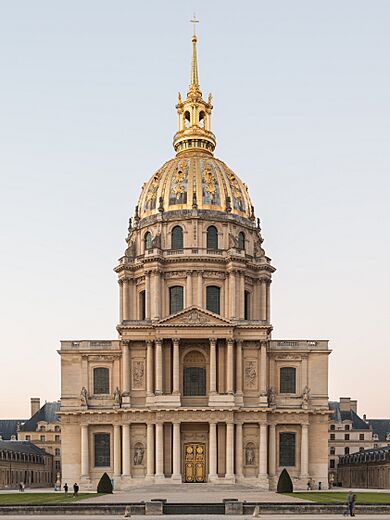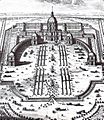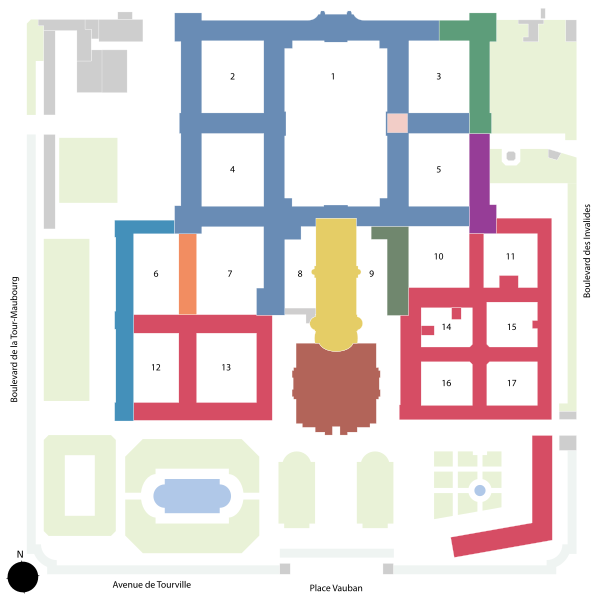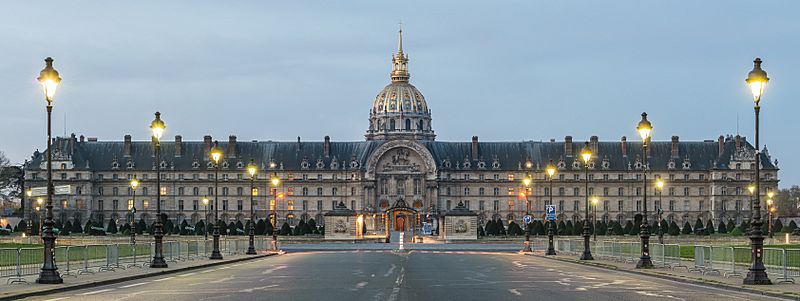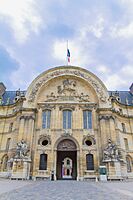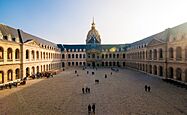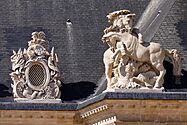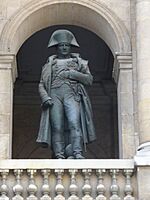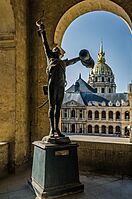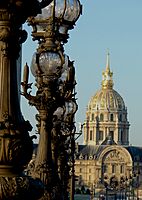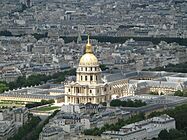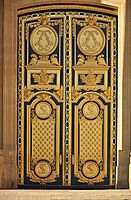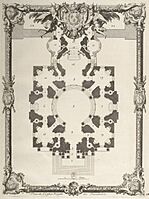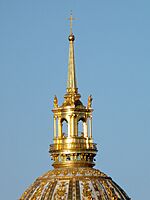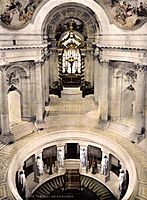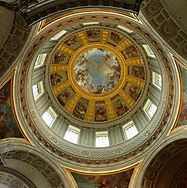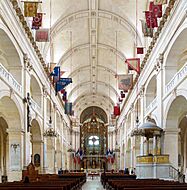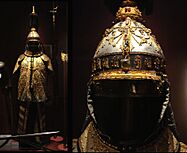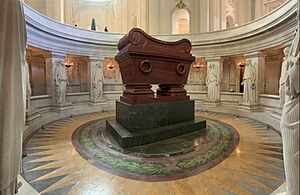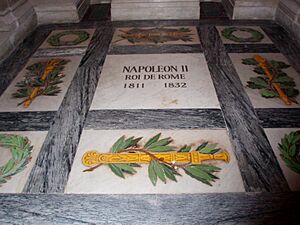Les Invalides facts for kids
Quick facts for kids Hôtel des Invalides |
|
|---|---|
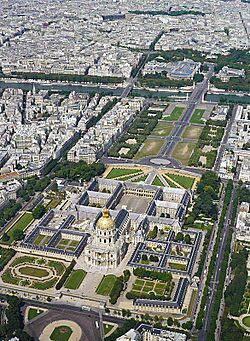
Aerial view of Les Invalides
|
|
| Alternative names | Les Invalides, Musée de l'Armée |
| General information | |
| Type | Museum, church, hospital, retirement home, mausoleum |
| Architectural style | Baroque |
| Location | Paris, France |
| Coordinates | 48°51′18″N 2°18′45″E / 48.85500°N 2.31250°E |
| Construction started | 1671 |
| Completed | 1706 |
| Inaugurated | 1678 |
| Design and construction | |
| Architect | Libéral Bruant Jules Hardouin-Mansart |
The Hôtel des Invalides (English: "house of invalids"), commonly called Les Invalides (French pronunciation: [lezɛ̃valid]), is a complex of buildings in the 7th arrondissement of Paris, France, containing museums and monuments, all relating to the military history of France, as well as a hospital and an Old Soldiers' retirement home, the building's original purpose. The buildings house the Musée de l'Armée, the military museum of the Army of France, the Musée des Plans-Reliefs, and the Musée d'Histoire Contemporaine. The complex also includes the former hospital chapel, now national cathedral of the French military, and the adjacent former Royal Chapel known as the Dôme des Invalides, the tallest church building in Paris at a height of 107 meters. The latter has been converted into a shrine of some of France's leading military figures, most notably the tomb of Napoleon.
Contents
History
Louis XIV initiated the project by an order dated 24 November 1670, as a home and hospital for aged and disabled (invalide) soldiers. The initial architect of Les Invalides was Libéral Bruant. The selected site was in the then suburban plain of Grenelle (plaine de Grenelle). By the time the enlarged project was completed in 1676, the façade fronting the Seine measured 196 metres (643 ft) in width, and the complex had fifteen courtyards, the largest being the cour d'honneur designed for military parades.
The church-and-chapel complex of the Invalides was designed by Jules Hardouin-Mansart from 1676, taking inspiration from his great-uncle François Mansart's design for a Chapelle des Bourbons to be built behind the chancel of the Basilica of Saint-Denis, the French monarch's necropolis since ancient times. Several projects were submitted in the mid-1660s by both Mansart and Gian Lorenzo Bernini who was residing in Paris at the time. Mansart's second project is very close to Hardouin-Mansart's concept of the Royal Chapel or Dome Church at Les Invalides, both in terms of its architecture and of its relationship with the adjacent church. Architectural historian Allan Braham has hypothesized that the domed chapel was initially intended to be a new burial place for the Bourbon Dynasty, but that project was not implemented. Instead, the massive building was designated as private chapel of the monarch, from which he could attend church service without having to mingle with the disabled veterans. It was barely used for that purpose. The Dôme des Invalides remains as one of the prime exemplars of French Baroque architecture, at 107 metres (351 ft) high, and also as an iconic symbol of France's absolute monarchy.
The interior of the dome was painted by Le Brun's disciple Charles de La Fosse with a Baroque illusionistic ceiling painting. The painting was completed in 1705.
Meanwhile, Hardouin-Mansart assisted the aged Bruant on the chapel, which was finished to Bruant's design after the latter's death in 1697. This chapel is known as the church of Saint-Louis-des-Invalides. Daily attendance of the veterans in the church services was required. Shortly after the veterans' chapel was started, Louis XIV commissioned Mansart to construct a separate private royal chapel, now known as the Église du Dôme from its most striking feature. The Dome chapel was finished in 1706.
-
Jules Hardouin-Mansart’s project with unrealized south esplanade
-
Portrait of Hardouin-Mansart by Hyacinthe Rigaud showing the Dome, Louvre
-
Napoleon I visiting the infirmary of Les Invalides
Because of its location and significance, the Invalides served as the scene for several key events in French history. On 14 July 1789 it was stormed by Parisian rioters who seized the cannons and muskets stored in its cellars to use against the Bastille later the same day. Napoleon was entombed under the Dome of the Invalides with great ceremony in 1840.
The separation between the two churches was reinforced in the 19th century with the erection of Napoleon's tomb, the creation of the two separate altars and then with the construction of a glass wall between the two chapels.
The building retained its primary function of a retirement home and hospital for military veterans (invalides) until the early twentieth century. In 1872 the musée d'artillerie (Artillery Museum) was located within the building to be joined by the musée historique des armées (Historical Museum of the Armies) in 1896. The two institutions were merged to form the present musée de l'armée in 1905. At the same time the veterans in residence were dispersed to smaller centres outside Paris. The reason was that the adoption of a mainly conscript army, after 1872, meant a substantial reduction in the numbers of veterans having the twenty or more years of military service formerly required to enter the Hôpital des Invalides. The building accordingly became too large for its original purpose. The modern complex does however still include the facilities detailed below for about a hundred elderly or incapacitated former soldiers.
When the Army Museum at Les Invalides was founded in 1905, the veterans' chapel was placed under its administrative control. It is now the cathedral of the Diocese of the French Armed Forces, officially known as Cathédrale Saint-Louis-des-Invalides.
Architecture
|
Dome of Les Invalides Cathédrale Saint-Louis-des-Invalides Musée de l'Armée Musée des Plans-Reliefs Musée de l'Ordre de la Libération |
Institution nationale des Invalides Gouverneur des Invalides Gouverneur militaire de Paris Chancellerie de l'Ordre de la Libération Office national des anciens combattants et victimes de guerre |
|
|
On the north front of Les Invalides, Hardouin-Mansart's Dome chapel is large enough to dominate the long façade, yet harmonizes with Bruant's door under an arched pediment. To the north, the courtyard (cour d'honneur) is extended by a wide public esplanade (Esplanade des Invalides) where the embassies of Austria and Finland are neighbors of the French Ministry of Foreign Affairs, all forming one of the grand open spaces in the heart of Paris. At its far end, the Pont Alexandre III links this grand urbanistic axis with the Petit Palais and the Grand Palais. The Pont des Invalides is next, downstream the Seine river.
The buildings still comprise the Institution Nationale des Invalides, a national institution for disabled war veterans. The institution comprises:
- a retirement home
- a medical and surgical centre
- a centre for external medical consultations.
Gallery
-
According to an old tradition, war trophies decorate the vault of the Cathédrale Saint-Louis-des-Invalides
-
The Qianlong Emperor's military costume at the Musée de l'Armée
Burials
The Dome chapel became a military necropolis when Napoleon in September 1800 designated it for the relocation of the tomb of Louis XIV's celebrated general Turenne, followed in 1807–1808 by Vauban. In 1835, the underground gallery below the church received the remains of 14 victims of the Giuseppe Marco Fieschi's failed assassination attempt on Louis-Philippe I. The major development came with the building's designation to become Napoleon's tomb by a law of 10 June 1840, as part of the political project of the retour des cendres orchestrated by king Louis-Philippe I and his minister Adolphe Thiers (the reference to Napoleon's cendres or "ashes" is actually to his mortal remains, as he had not been cremated). The creation of the crypt and of Napoleon's massive sarcophagus took twenty years to complete and was finished in 1861. By then, it was emperor Napoleon III who was in power and oversaw the ceremony of the transfer of his remains from a chapel of the church to the crypt beneath the dome.
Inside the Église du Dôme des Invalides
The most notable tomb at Les Invalides is that of Napoleon Bonaparte (1769–1821), designed by Louis Visconti with sculptures by James Pradier, Pierre-Charles Simart and Francisque Joseph Duret. Napoleon was initially interred on Saint Helena, but King Louis Philippe arranged for his remains to be brought to France in 1840, an event known as le retour des cendres. Napoléon's remains were kept in the Saint Jerome (southwestern) chapel of the Dome church for more than two decades until his final resting place, a tomb made of red quartzite and resting on a green granite base, was finished in 1861.
Other military figures and members of Napoleon's family also buried at the Dome church, by year of burial there:
- 1800: Henri de La Tour d'Auvergne, Viscount of Turenne (1611–1675); 1670s monument by Gaspard Marsy and Jean-Baptiste Tuby, originally at the Basilica of Saint-Denis and relocated by Napoleon
- 1807–1808: heart of Sébastien Le Prestre de Vauban (1633–1707); relocated by Napoleon from Bazoches, replaced in 1847 with a cenotaph by Antoine Étex
- 1847: Henri Gatien Bertrand (1773–1844), army general who accompanied Napoleon to Elba and then St Helena, and in 1840 brought Napoleon's body back to France; monument designed by Louis Visconti
- 1847: Géraud Duroc (1772–1813); also by Louis Visconti
- 1862: Jérôme Bonaparte (1784–1860), Napoleon's youngest brother, Governor of the Invalides 1848–1852; monument by Alfred-Nicolas Normand with sculpture by Eugène Guillaume, in the Saint Jerome chapel
- 1864: Joseph Bonaparte (1768–1844), Napoleon's elder brother; monument by Alphonse-Nicolas Crépinet in the Saint Augustine (southeastern) chapel
- Charles Leclerc (1772–1802); urn relocated from the Château de Montgobert
- 1904: heart of Théophile Corret de la Tour d'Auvergne (1743–1800), named by Napoleon the "first grenadier of the Republic"
- 1940: Napoleon II (1811–1832) son of Napoleon (his heart and intestines remained in Vienna); first placed in the church's Saint Jerome Chapel, then buried in the crypt in 1969
- 1858: heart of Catharina of Württemberg (1783–1835), wife of Jérôme Bonaparte, and their son Jérôme Napoléon Charles Bonaparte, in the underground gallery; the monument of Catharina's heart was relocated in 1862 in the Saint Jerome Chapel
- 1937: Ferdinand Foch (1851–1929), monument by Paul Landowski in the Saint Ambrose (northeastern) chapel
- 1963: Hubert Lyautey (1854–1934), relocated from Morocco, monument by Albert Laprade in the Saint Gregory (northwestern) chapel
-
Tomb of Ferdinand Foch in the Dome church
Beneath the Cathédrale Saint-Louis-des-Invalides
82 additional military figures, including 28 Governors of Les Invalides, are buried in the Caveau des Gouverneurs, an underground gallery beneath the Cathédrale Saint-Louis-des-Invalides:
- Albert d'Amade (1856–1941)
- Jean-Toussaint Arrighi de Casanova (1778–1853), Governor 1852–1853
- Louis Baraguey d'Hilliers (1764–1813) (heart)
- Achille Baraguey d'Hilliers (1795–1878), Marshal of France
- Jean-François Berruyer (1737?–1804), Governor 1803–1804
- Jean-Baptiste Bessières (1768–1813), Marshal of the Empire
- Baptiste Pierre Bisson (1767–1811) (heart)
- Antoine Baucheron de Boissoudy (1864–1926)
- Thomas Bugeaud (1784–1849), Marshal of France, involved in the conquest of Algeria
- François Canrobert (1809–1895), Marshal of France
- François-Henri de Franquetot de Coigny (1737–1821), Marshal of France, Governor 1816–1821
- Victor Cordonnier (1858–1936)
- Charles-Marie Denys de Damrémont (1783–1837)
- Vincent Martel Deconchy (1768–1823) (heart)
- Denis Auguste Duchêne (1862–1950)
- Guy-Victor Duperré (1775–1846)
- Franciade Fleurus Duvivier (1794–1848)
- Jean Baptiste Eblé (1758–1812) (heart)
- Louis Franchet d'Espèrey (1856–1942), Marshal of France
- Rémy Joseph Isidore Exelmans (1775–1852), Marshal of France
- Émile Fayolle (1852–1928), Marshal of France
- Ernest François Fournier (1842–1934)
- Dominique-Marie Gauchet (1853–1931)
- Augustin Gérard (1857–1926)
- Henri Giraud (1879–1949)
- Émile Guépratte (1856–1939)
- Adolphe Guillaumat (1863–1940)
- Ferdinand-Alphonse Hamelin (1796–1864)
- Jean-Joseph Ange d'Hautpoul (1754–1807) (heart)
- Paul Prosper Henrys (1862–1943)
- Jean Houdemon (1885–1960), Governor 1951–1960
- Georges Louis Humbert (1862–1921)
- Jean-Baptiste Jourdan (1762–1833), Marshal of the Empire, Governor 1830–1833
- Alphonse Juin (1888–1967), Marshal of France
- Jean-Baptiste Kléber (1753–1800) (heart)
- Fernand de Langle de Cary (1849–1927)
- Charles Lanrezac (1852–1925)
- Augustin Boué de Lapeyrère (1852–1924)
- Jean Ambroise Baston de Lariboisière (1759–1812)
- Dominique Jean Larrey (1766–1842), celebrated military surgeon
- Antoine Charles Louis de Lasalle (1777–1809), the "Hussar General"
- Philippe Leclerc de Hauteclocque (1902–1947), Marshal of France
- Patrice de MacMahon (1808–1893), Marshal of France and President of France
- Paul Maistre (1858–1922)
- Gabriel Malleterre (1858–1923), Governor 1919–1923
- Charles Mangin (1866–1925)
- Augustin Eugène Mariaux (1864–1944), Governor 1923–1944
- Edmond-Charles de Martimprey (1808–1883), Governor 1870–1871
- Louis de Maud'huy (1857–1921)
- Michel-Joseph Maunoury (1847–1923), posthumous Marshal of France
- Antoine de Mitry (1857–1924)
- Gabriel Jean Joseph Molitor (1770–1849), Marshal of France, Governor 1847–1848
- Bon-Adrien Jeannot de Moncey (1754–1842), Marshal of the Empire, Governor 1833–1842
- Raoul Magrin-Vernerey a.k.a. Ralph Monclar (1892–1964), Governor 1862–1864
- Georges Mouton (1770–1838), Marshal of France
- François-Marie-Casimir Négrier (1788–1848) (heart)
- Robert Nivelle (1856–1924)
- Nicolas d'Orange des Roches (1618–1705), Governor 1696–1705
- Philippe Antoine d'Ornano (1784–1863), Marshal of France, Governor 1853–1863
- Nicolas Oudinot (1767–1847), Marshal of the Empire, Governor 1842–1847
- Paul Pau (1848–1932)
- Aimable Pélissier (1794–1864), Marshal of France
- Henri Putz (1859–1925)
- Antoine Rodes (1870–1951), Governor 1944–1951
- Pierre Alexis Ronarc'h (1865–1940)
- Pierre Roques (1856–1920), creator of the French Air Force
- Claude Joseph Rouget de Lisle (1760–1836), army captain, author of France's national anthem La Marseillaise
- Pierre Ruffey (1851–1928)
- Auguste Regnaud de Saint-Jean d'Angély (1794–1870), Marshal of France
- Jacques Leroy de Saint-Arnaud (1798–1854), Marshal of France
- Maurice Sarrail (1856–1929) (heart)
- Horace François Bastien Sébastiani de La Porta (1771–1851), Marshal of France
- Jean-Mathieu-Philibert Sérurier (1742–1819), Marshal of France, Governor 1804–1815
- Victor d'Urbal (1858–1943)
- Sylvain Charles Valée (1773–1846), Marshal of France
Two of these, Gabriel Malleterre and Philippe Leclerc de Hauteclocque, are also honored with a plaque inside the Saint-Louis-des-Invalides cathedral. Another plaque honors Jean de Lattre de Tassigny (1889–1952), posthumous Marshal of France, commander of the French First Army during World War II and later commander in the First Indochina War, who is buried in Mouilleron-en-Pareds.
See also
 In Spanish: Los Inválidos para niños
In Spanish: Los Inválidos para niños
- List of museums in Paris
- List of hospitals in France
- List of tallest structures in Paris
- List of tourist attractions in Paris
- List of tallest domes
- Military history of France
- San Francisco City Hall, the design of which was influenced by Les Invalides
- La Tour-Maubourg, adjacent Paris Metro stop convenient to Les Invalides
- National Pantheon of Venezuela
- Buenos Aires Metropolitan Cathedral
- National Pantheon of the Heroes
- Altar de la Patria
- Artigas Mausoleum
- List of works by James Pradier
- History of early modern period domes


